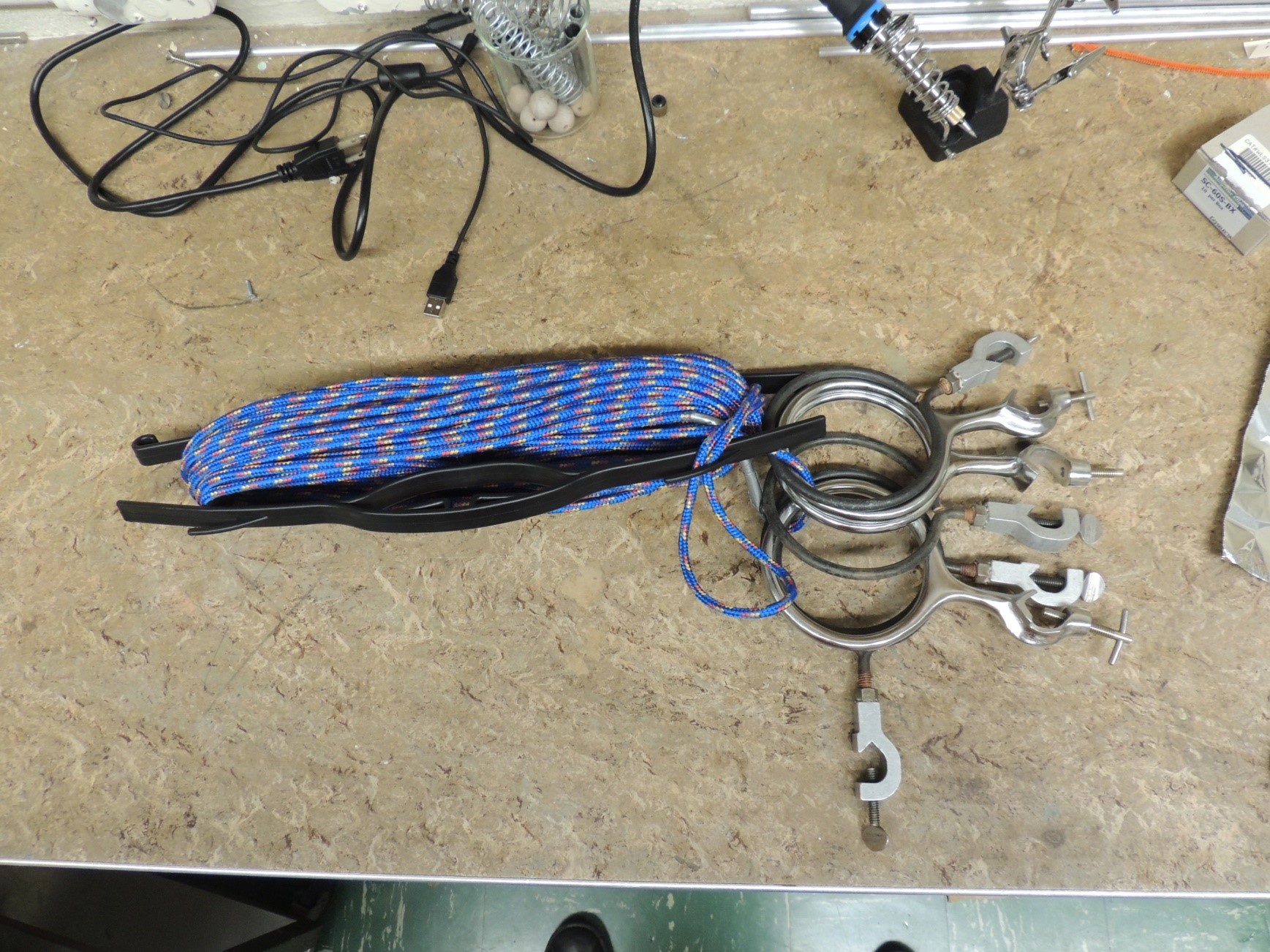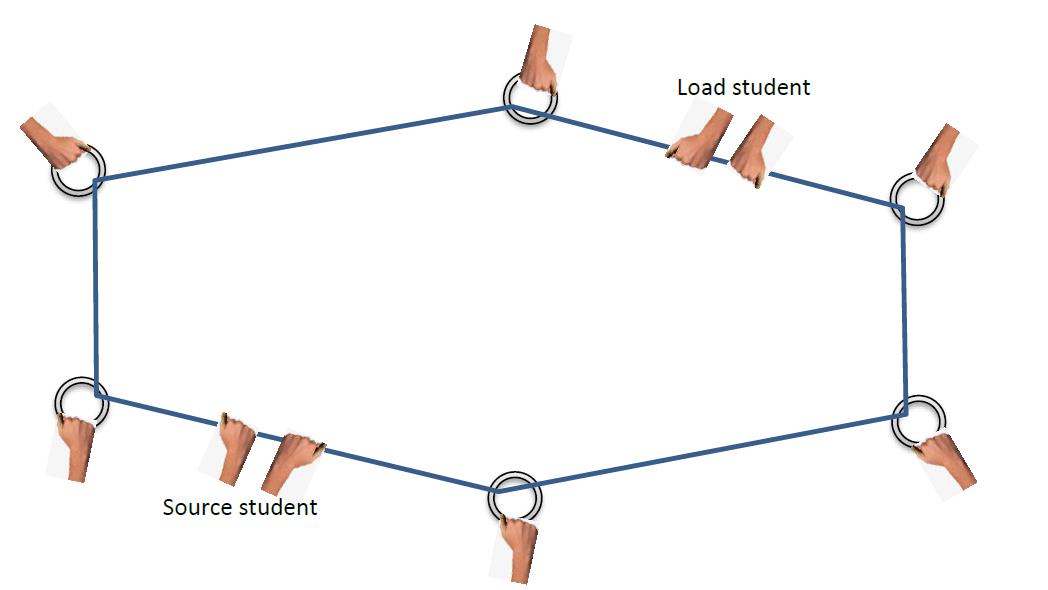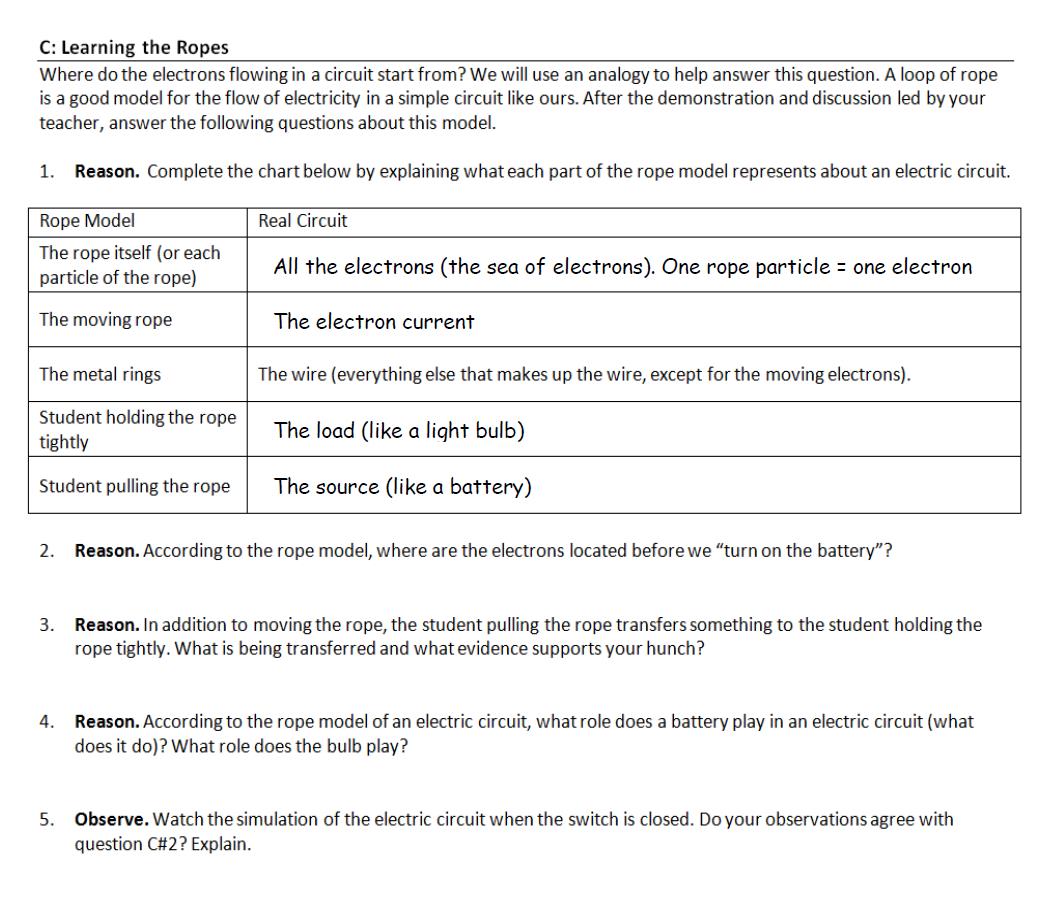December 08, 2018 Filed in:
ArticlesChris Meyer, President OAPT
christopher.meyer@tdsb.on.ca
Electricity is almost always invisible; we never get to see electrons doing their thing. Only occasionally do we observe some by-product of electrical shenanigans like a spark, a glow, or a warm battery. This makes learning about electricity tough. As a result, many students (and even some teachers!) don’t develop a clear mental model representing how electrons move in a circuit. There are two important ideas are often missing from our mental models:
Key Idea: Current electrons are found everywhere in the circuit. When a circuit is “turned on”, electrons begin moving from every point in the circuit at the same time (give or take a few billionths of a second).
Key Idea: The battery (or source in general) adds energy to the system of the electrons.
Demonstration: I have a large loop of rope that goes around our entire classroom. The rope is threaded through a bunch of iron ring clamps.


I have my students stand around the perimeter of room to observe. Six students are spaced around the room and hold on to the iron rings. The rope is threaded through the rings and forms a big loop around all the desks. I choose another student to loosely wrap their hands around the rope itself; this student will serve as a “load”. One last student gets the job of pulling the rope through the iron rings; this student is the “source”.

The YouTube video below that I found on the interwebs shows a bunch of teachers doing a version of this. The presenter has all the teachers holding the rope, which is different from what I do. I prefer students using iron rings since it reduces the amount of hand friction on my large rope.

When the source students starts pulling the rope and moving it through the iron rings, our “rope circuit” running and I begin to discuss the model we are creating with my class. Here is the chart and questions I use with my students.
 The Battery is not a Source of Electrons
The Battery is not a Source of Electrons
A common idea that arises naturally in the study of electricity is that the battery is the source of the electrons in a circuit (this is incorrect). The water pipe model of circuits might promote this faulty idea if we think of the pipes as being empty before you turn on the taps (the pump or source of water). A water model would be more reliable if we understand that the pipes are always full of water. Even if you have never mentioned the water/pipe model, students are likely to believe that the battery is the source of the electrons and that the wires are basically empty conduits. The rope model helps make clear that the rope (the electron sea) is everywhere even when the source is turned off. As soon as the student starts pulling on the rope, the rope begins to move everywhere at once (or almost, depending on the amount of slack in the rope). In this model, it doesn’t make any sense to ask, “where does the rope start or end?” just as it doesn’t for electrons in a simple circuit. Another great observation is to compare the speed of the rope particles throughout the loop. The speeds are the same, just like the electron current would be everywhere in a series circuit, no matter the number of elements in that circuit.
The Battery is a Source of Energy
After we tackle the “battery is not a source of electrons” idea, I will ask the ”load” student to hold the rope more tightly. When that happens, the “source” student pulling the rope will report that it has become harder to pull and the “load” student will report that their hands are becoming warm (they might report this loudly). You can even add another student holding the rope (another load) and things will get really tough for the source student. Why is the source student getting tired? Because they are using energy! Why do the hands of the load students get warm? They are gaining energy! Where did that energy come from? The source! I use very careful language to describe energy in a circuit, saying that the source adds energy to the circuit (the system of electrons) and the load removes energy form the circuit (the system of electrons). I don’t say that electrons “carry the energy” through the circuit because that is not correct; explaining why requires a much more in-depth look at the behaviour of circuits*.
Previewing Resistance, Ohm’s Law, and the Addition of Circuit Elements
A fun part of this model is that you can hint at many other current electricity ideas. If you increase how tight the load student holds the rope, the source student feels more resistance and the current drops. This is Ohm’s law in action. Add in other student loads and sources and you model how circuits respond to the addition of more elements in series.
Models have Limitations
All analogs or teaching models have limitations. They might describe some things very well, but other things very poorly. For example, the rope model cannot describe parallel connections at all. The rope model also ignores the random collision of the electrons with the atoms of the wire, as represented in the
Drude model of current flow, which helps explain the phenomenon of resistance. Also, the idea that the rope represents the sea of electrons (the conduction electrons only) and not the complete wire is challenging for students. I like to follow up the rope model with the PhET simulation shown below. This allows us to observe small blue spheres, representing electrons, move about the circuit. I find it helpful to map the ideas from the rope model to this simulation. I hope you find the rope model helpful in your teaching. I would be happy to hear how it goes!
*Curious and adventurous teachers should explore the ideas of surface charge and the storage of energy in the electric field created by the battery. I recommend Chabay and Sherwood’s text
Matter and Interactions.
Tags: Electricity




